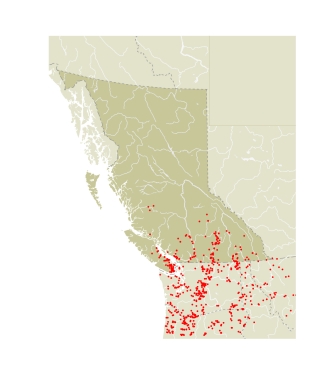Linnaeus divided butterflies into several groups. The first group was the swallowtails, which were called equites or knights. Those with red on the thorax were Greek heroes, those with no red on the thorax were Roman heroes (Emmet 1991). Papilio, which is Latin for butterfly, was the original generic name that Linnaeus used for all butterflies. The common name was first used in Britain in 1766 for "The Swallowtail," P. machaon (Bretherton 1990b), in reference to the resemblance of the tails on the hindwings to the tails of swallows. The name was later extended to include the entire genus. Gosse (1840) was the first to use the common name "swallowtails" in North America.
Swallowtails found in North America are large, brightly coloured butterflies with tails on their hindwings. Six of the eight species in BC are yellow with black stripes. In addition, Pale Swallowtails are white to very pale yellow with black stripes, and Indra Swallowtails are mostly black. Swallowtails also have an orange eyespot at the base of each hindwing tail, and orange and blue spots on the ventral hindwings.
Eggs are smooth and hemispherical, and are cream, yellow, yellow green, or green when laid. The egg colour darkens, and a red ring develops around the top before hatching. Young larvae are black with a white saddle, and resemble bird droppings. Larvae of all ages have well-developed osmeteria, extrusible Y-shaped glands on the top of the thorax that produce defensive chemicals in response to attack. Pupae have two small horns on the head and a point at the top of the thorax. A silk girdle holds them head up against a stem.
The eggs are laid on the leaves of the larval foodplants. On plants with large flat leaves, the eggs are laid on the top or occasionally just under the leaf edge. Both the top and bottom of small leaves are used. The pupae overwinter. In BC two species have more than one generation each year in some populations; the other six are univoltine.
Hancock (1983) split the genus Papilio into six genera, two of which (Papilio and Pterourus) are in BC. We treat Hancock's genera as subgenera of a single large genus, Papilio, as do most recent authors.
Higgins (1975) suggested that the North American populations of Old World Swallowtails may not be the same species as Papilio machaon. Eitschberger (1993) found that the rings of plates surrounding the egg micropyle are significantly different between one European machaon subspecies and subspecies aliaska, the North American subspecies closest to European machaon. European P. machaon has 3 rings with about 112 plates around the micropyle, while aliaska has 5 rings with about 142 plates. A second character used by Eitschberger to separate P. machaon from aliaska, the number of teeth on the harpe of the male genitalia, is not useful in separating species in North America. The difference in egg structure is insufficient to split the species without additional data, hence we continue to treat the North American populations as subspecies of Papilio machaon.
All the tiger swallowtails (subgenus Pterourus) hybridize in the wild to some extent. In southern BC there is a broad zone of hybridization between Canadian Tiger Swallowtails and Western Tiger Swallowtails from Manning Provincial Park east to Creston. In the areas where their ranges overlap, Western Tiger Swallowtails prefer low-elevation deciduous forest habitats whereas
Canadian Tiger Swallowtails prefer higher-elevation boreal forest habitats. Hybridization between Pale Swallowtails and Western Tiger Swallowtails is rare, but Wagner (1978) collected a perfectly intermediate male hybrid in the wild in Idaho. Jon and Sigrid Shepard found a male hybrid of the Pale Swallowtail and the Canadian Swallowtail 10 km south of Galloway, BC. lt is intermediate in appearance between the two species.
Similarly all the Old World swallowtails (subgenus Papilio) occasionally hybridize in the wild. The Old World swallowtail species are most easily distinguished by the overall coloration of the hindwing and by the colour of the eyespot at the base of the tail on the hindwing.
|
